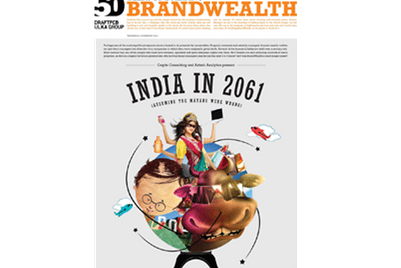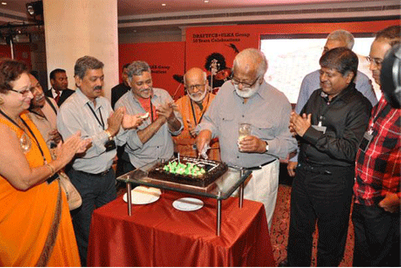
DraftFCB Ulka has launched a new brand analytics division called Asterii Analytics. The division will be headquartered out of Mumbai and executive director Niteen Bhawat has been appointed chief executive officer. Paula Fedoris, executive vice president and chief analytics officer, DraftFCB, was also in Mumbai for the launch on 22 February.
CI: What is the reason for launching Asterii Analytics in India at the present moment?
Paula Fedoris (PF): Our company has always been dedicated to making sure that what we do for our clients is successful. One way of being a part of their success is by being accountable to make sure their marketing dollars are being spent as efficiently and effectively as possible. All of these new opportunities, such as Asterii, are basically living by that philosophy.
Niteen Bhagwat (NB): It’s a completely new practice. For 50 years, we’ve been creating “Brand Wealth” for our clients. In today’s day and age, competition is intensifying and the way you take decisions is changing (15 years ago, it was a case of ‘This is what I think; versus this is what I know’). Analytics is about what you know; it is about harvesting hard numbers, and creating irrefutable evidence of what the right decisions could be. Hence the need to build that capability and offer it to clients.
CI: Does Asterii come in at the beginning or the end of the creative process?
NB: Asterii is a standalone service; it’s a separate company. Asterii is agnostic, but we will support all the group companies, or companies which are not working with the group. It can come in either at the beginning or later in a process, it can be linked to communication development or it can be totally independent of communication development, as an activity. Having said that, what Paula genuinely believes, is that it has to come at the beginning.
PF: It’s about defining success and then orchestrating success, and the best way to do that is to be a part of those upfront conversations so that everyone has an alignment of what we are trying to achieve.
CI: Are there any projects that you have worked on using analytics (internationally), that you could cite examples of?
PF: One of the cases was an automotive one last year, and this particular client was a global one who had 1800 different locations. What they wanted us to do , was to find out a new way to segment all those customers and also to develop a promotional calendar, which would show how the company could look at what they are buying, in order to make some more informed decisions of what they were offering. It was a combination of advanced analytics per segmentation and some market basket analytics in order to form the promotional calendar, and we put that together to get some stunning results: doubling the return on investment and a 300% return on optimizing surfing. So if you get the formula right, you end up getting superior impact.
CI: Are clients over here asking for analytics? Couldn’t they go to a research firm?
NB: There has been research that has been done for the last 25- 30 years. Research generates numbers, which may or may not be interpreted but not necessarily analytics. Analytics is a process, which starts from what your goals are, what your performance indicators are, and how are you going to measure against them. The tipping point that happened in the West a decade or two ago, is happening in India right now, where companies are going to see a lot more data. Analytics means that you are going to see patterns and trends in the data, to understand the customer better. So today, there are companies, that are the first movers, which are financial services, for example, credit card companies, which are using a lot of analytics, and the same is happening in India and the moment FDI opens up for retail, you will see a lot of analytics happening in retail. Within that context, Asterii is about the pricing policies, the kind of segmentation, how will you the up-sell or cross-sell your products.
PF: I think your airlines are already having a lot of that. The leisure industry has loyalty cards as well, so any point of contact that is collecting consumer data shows that your industries are already transforming.
NB: The second occurrence is media inflation, and on the other hand fragmentation. As the costs start going up, the risks of success or failure increase. At the same time we know that companies will be under pressure on the bottom line. In that kind of a scenario, analytics can help with marketing mix modelling and media mix modelling, which will allow clients to optimise their expenses.
CI: Have you signed up any clients as yet?
NB: We have just started talking, and they seem to be very interested.
CI: What would the team set-up be, and what is the kind of talent that you would draw in?
NB: Globally, we have about 100 people, who report to Paula, and we’ll have access to the global team. In India, we hope that the team size will scale up to 30-40 people in the next 12-14 months. We do have some people on board already. Typically the profile of the people will be engineers with a quantitative background or doctorates in mathematics and statistics or MSC in statistics. The recruitment is on.
CI: What kind of investment has DraftFCB put in to Asterii Analytics? Can you share any numbers?
NB: Let me put it differently, the Group always believes in any new initiative that we get into. In this case, I cannot give a number, not because I do not I do not want to give a number, but because we do not have a number in mind. We will invest whatever it would take. We don’t have a resource crunch, in terms of investing. More importantly, as an organisation we will stay invested for the next 3-10 years that it takes to build a world-class organisation. Unlike a lot of other companies, who start a division and then shut it, in our group, we don’t shut anything ever because we know it takes time. We have got into analytics, not from the point of view of revenue, but from capability. It’s a promise that we have made to our clients to add value. It’s a separate business, because it’s a high cost activity and it requires a certain degree of focus.
PF: The fact is that we want to heighten our profile globally. If you look around globally, there are not a lot of folks that have this title of chief analytics officer yet. It’s because the capability and its value has really only surfaced over the past five years. All of a sudden, over the past 20 years, there is more data to mine and so the skill set has exploded by the number of people. But it is really difficult to find the right mix of talent that is highly quantitative and also financial because you really want to look at the profitability and the performance as well as understanding marketing. For those who come onboard but don’t have all that knowledge, we are going to have a very rigorous training course so that we can teach them what marketing is all about in the new millennium and also the new techniques that are out there. With social media exploding and the way we need to harness all the data that’s being created by our interaction with social media, that’s going to be important differentiator in what the team is going to be building.
NB: Paula has a great view on social media and we want to enlarge on the importance of social media analytics and why social media is suddenly important.
PF: We have been collecting a lot of interesting statistics of how much data is being generated and how rapidly, adoption curves are changing. There are 92 billion viewers on YouTube and 48 hours uploaded every single day. The kind of volume that is associated with that is tremendous or that a quarter of all time spent on the internet in spent in social channels that translate to a tremendous amount of time and data. No wonder we have to mine all this.
CI: Is Asterii going to be based out of India first, and then be taken abroad?
NB: No, it’s going to be an India operation. We will get work from global clients but at this point of time it is very clearly focused on India and headquartered in Mumbai.
CI: Any other branches in India?
NB: No, right now we will operate out of Mumbai, because this kind of work doesn’t require servicing in the classical sense of advertising, where you have to go running with the layout. This can be done easily out of a single location.


.jpg&h=334&w=500&q=100&v=20250320&c=1)
.jpg&h=334&w=500&q=100&v=20250320&c=1)

.jpg&h=334&w=500&q=100&v=20250320&c=1)


.jpg&h=334&w=500&q=100&v=20250320&c=1)


.jpg&h=334&w=500&q=100&v=20250320&c=1)



.png&h=268&w=401&q=100&v=20250320&c=1)

.jpg&h=268&w=401&q=100&v=20250320&c=1)


